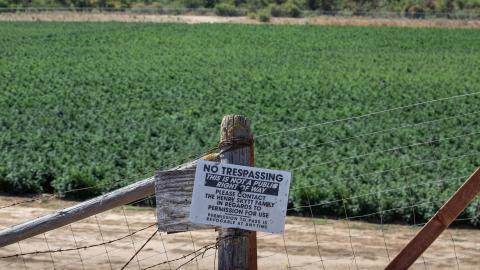For years, cannabis advocates claimed that legalizing recreational marijuana would benefit America. But more than a decade into the experiment, it’s clear that legalization has been nothing short of a disaster.
Recreational marijuana use has steadily increased across the country. Forty-four percent of people between the ages of 19 and 30 reported marijuana use in 2022, up from 35 percent in 2017 and 28 percent in 2012. One in ten of that same age group admitted to daily use—a number that has doubled in the past decade.
Legalization has made marijuana more accessible and more acceptable, in part because it has created the false perception that the drug is “safe.” Advocates have downplayed the health risks, touting it as a largely harmless and nonaddictive drug. But today’s marijuana packs seven to 30 times the punch of Woodstock-era weed. Due to this recent, deliberate engineering of hyperpotent marijuana, we don’t yet have a full understanding of its health risks because most studies have been based on the far less potent product of the past.
It has been grossly irresponsible to legalize this potent drug for recreational use before rigorous evaluation. Even potentially lifesaving cancer drugs are withheld from the market until their effects have been studied. But states have rushed to make recreational marijuana easily available, without FDA approval, without adequate control, and before its health consequences are fully understood.
What we know already is alarming. It’s conservatively estimated that one in three people who use marijuana become addicted. (And its novel hyperpotency will likely cause even more addiction in the future.) There’s compelling evidence that marijuana damages mental health as well as cognitive, emotional, and social development. THC, the psychoactive component in cannabis, produces a high by altering brain chemistry and interfering with the nervous system’s normal functioning. With repeated use, this chemical alteration causes long-lasting effects, increasing the risk of psychosis, schizophrenia, social anxiety, and suicidal ideation. As more people use marijuana—54 percent of users are considered “high frequency” users by the industry, accounting for the vast majority of weed consumption—its harmful effects will become more apparent.
There’s mounting evidence that marijuana use poses a risk not just to mental but physical health. According to the CDC, marijuana has many of the same harmful effects as tobacco, containing many of the same toxic and carcinogenic chemicals, some in even higher amounts. And a recent study shows the significant cardiovascular risks of cannabis: regular marijuana use may increase the risk of heart attack and stroke. By legalizing weed without FDA approval, states have laid the groundwork for another “Big Tobacco,” which gained social acceptance before the dangers of smoking were fully appreciated. Why are we rushing to repeat history with the marijuana industry?
States with liberal cannabis laws have seen a significant increase in marijuana-related ER visits, including a spike in teenagers visiting the ER. At the University of Colorado Hospital, the number of cannabis-related visits tripled between 2012 and 2016. The reasons for these visits? Bodily injury, respiratory trouble, and persistent bouts of vomiting, among others.
One in three DUIs issued by Colorado law enforcement in 2020 identified marijuana as an impairing substance. Sadly, the consequences of driving while high also fall on nonusers who are injured—or killed—by impaired drivers.
And then there are young people, the most vulnerable victims of legal weed. Adolescent cannabis abuse has increased by 245 percent over the past two decades. Although parents are increasingly mobilizing to oppose addictive social media, marijuana has yet to gain mainstream attention—partly because parents often don’t realize the unique risks associated with high-potency cannabis.
Studies have found that teens who regularly use marijuana experience an eight-point decrease in IQ, surpassing the brain damage caused by extremely high exposure to lead. Additionally, health experts have long warned that cannabis use can interfere with the ability of young people to form relationships, succeed academically, and hold down a job.
Advocates claimed that the social ills associated with the trafficking of illegal weed would abate if its use became legal. But legalization has only exacerbated preexisting problems—and introduced new ones.
Far from eliminating the black market, legalization has facilitated its proliferation. The market for illicit marijuana is seven times as large as the demand in the legal market. Black-market weed isn’t inspected or regulated, and it frequently contains harmful heavy metals, pesticides, and other contaminants. And these risks aren’t just confined to people who buy from illegal dealers. In 2019, it was estimated that 80 percent of the weed sold by legal dispensaries in California was sourced from the black market, introducing unknown hazards to unsuspecting consumers.
Legal weed remains a magnet for crime, too. The Federal Reserve Bank of Kansas recently found that most states that legalized recreational marijuana experienced an average 13 percent increase in arrests and a staggering 35 percent increase in chronic homelessness. Colorado, Alaska, and Oregon saw large spikes in violent crime following legalization. In Denver, where dispensaries make up less than one percent of business, they account for six percent of all reported commercial burglaries.
In the cannabis advocates’ pipe dream, taxes from the sale of marijuana would generate valuable revenue for state budgets. But in reality, American families have footed the bill for damage done by a destructive minority of users. In Colorado, the Centennial Institute calculated that every dollar of cannabis-related tax revenue has been offset by $4.50 in costs due to marijuana-related traffic fatalities, hospital care, and lost productivity.
Marijuana isn’t good for the body, and it certainly isn’t good for the body politic. Legalization has failed to reduce the social pathologies associated with illegal marijuana use. Instead, it has exacerbated these ills, spawned new ones, and imposed higher costs on society. Not least, greater marijuana use has contributed to the steady erosion of the civic responsibility, self-discipline, and sobriety required of citizens to sustain our system of limited government and broad personal liberty. A doped-up country is a nation in decline.




















